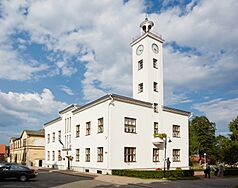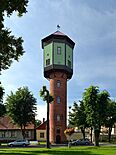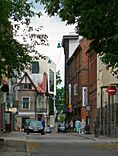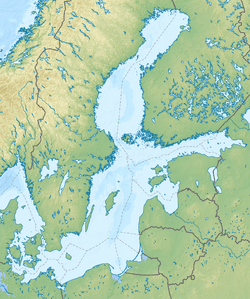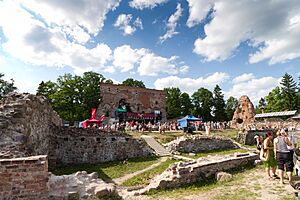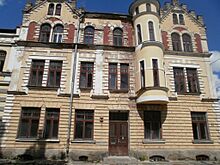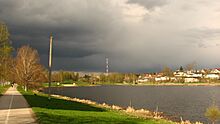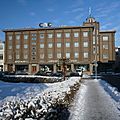Viljandi facts for kids
Quick facts for kids
Viljandi
|
|||
|---|---|---|---|
|
Clockwise from top: Viljandi town hall; Old water tower; downtown; Ugala theatre; University of Tartu Viljandi Culture Academy, St. John's church; Sakala Centre
|
|||
|
|||
| Country | |||
| County | |||
| Founded | 1283 | ||
| Area | |||
| • Total | 14.62 km2 (5.64 sq mi) | ||
| Elevation | 83 m (272 ft) | ||
| Population
(2019)
|
|||
| • Total | 17,407 | ||
| • Rank | 6th | ||
| • Density | 1,190.6/km2 (3,083.7/sq mi) | ||
| Ethnicity | |||
| • Estonians | 94% | ||
| • Russians | 3% | ||
| • other | 2.1% | ||
| Time zone | UTC+2 (EET) | ||
| • Summer (DST) | UTC+3 (EEST) | ||
| Postal code |
71020
|
||
| ISO 3166 code | EE-897 | ||
| Website | www.viljandi.ee | ||
Viljandi is a cool town and municipality in southern Estonia. About 17,400 people lived there in 2019. It's the main city of Viljandi County and is located between two other big Estonian cities, Pärnu and Tartu. Viljandi was first mentioned in 1283 when it got its town charter. It became part of the Hanseatic League in the early 1300s. This was a powerful group of trading cities. Viljandi is one of five Estonian towns that were part of this league.
The famous Estonian newspaper Sakala started in Viljandi in 1878.
Contents
- Viljandi's Symbols
- A Look at Viljandi's History
- Viljandi's Culture Scene
- Who Lives in Viljandi?
- Viljandi's Geography
- Viljandi's Economy
- Getting Around in Viljandi
- Learning in Viljandi
- Sports in Viljandi
- Viljandi Legends
- Viljandi's International Connections
- Fun Events in Viljandi
- Famous People from Viljandi
- Images for kids
- See also
Viljandi's Symbols
The flag of Viljandi has two colors: light blue on top and white on the bottom. The city's coat of arms is a light blue shield with a white rose in the middle. Viljandi is known as the "white rose city." In summer, especially around the city's anniversary in 2003, 720 white roses bloom in front of the city hall. People even celebrate a "White Rose Day" in Viljandi during the summer!
A Look at Viljandi's History
People have lived around Viljandi for a very long time, since about 5000 B.C. The first written mention of a strong fort in Viljandi was in 1154. It was in a world map book called Geography.
In the 12th century, a town grew up around the Viljandi fort. It became an important trading spot for the Sakala area.
Battles and Castles
In 1211, an army from Germany, Latvia, and Livonia attacked the fort in Viljandi. Later, in 1223, a group called the Livonian Sword Brethren (who later became the Livonian Order) took over the fort. They captured it from people from Kievan Rus' who were helping the Estonians.
In 1224, a strong Order Centre was started where the old wooden fort used to be. The next year, a leader named Volquin began building Viljandi Castle. This castle became one of the biggest in the Baltic region. It was a very important fort for the Livonian Order and was constantly rebuilt and made stronger for 200 years.
A Trading Town
In the 13th century, a medieval town grew on the north side of the castle. In 1283, records first showed the town's rules, land, and people. Viljandi joined the powerful Hanseatic League in the early 1300s. This made it a key stop for merchants traveling to and from Russia. In 1365, the town council even helped make peace between Denmark and the Hanseatic League.
Viljandi was a typical small trading town in the Middle Ages. It earned most of its money from goods passing through. Local shops and crafts were also very important. In 1481, Ivan III of Russia tried to capture the castle but failed.
Times of Destruction and Rebirth
Viljandi started to decline during the Livonian War. In 1560, an army from Muscovite Russia attacked and destroyed the town and the fort.
During the Polish–Russian Wars in the early 1600s, the town and fort were destroyed again. When Sweden ruled in the 17th century, Viljandi's town rules were even canceled.
After the Great Northern War, the Russians took control. Viljandi didn't have its own laws again until 1783. That year, Catherine the Great brought back town laws, and Viljandi became a district town. This helped Viljandi grow again. The number of people living there started to increase, and crafts, trade, and cultural life became lively once more.
In 2005, a company called Estonian Match, which came from the old Viljandi Match Factory, made a six-meter-long match. It was so big it was put in the Guinness Book of Records as the largest match in the world!
Viljandi's Culture Scene
Viljandi is sometimes called the cultural capital of Estonia. This is partly because the Viljandi Culture Academy is located here.
- Ugala Theatre has been putting on plays since 1920. They also have a tradition of outdoor shows.
- Viljandi Puppet Theatre
- Sakala Centre
- Viljandi Library was built in 2002. It's also a place for art shows, meetings with famous people, and cultural talks.
- Kondas Centre is a special art center named after Estonian artist Paul Kondas. It shows art from a style called "naïvism" and is a meeting place for artists.
- Estonian Traditional Music Centre is in a restored building in the Castle ruins. It helps share and teach traditional music.
Who Lives in Viljandi?
Viljandi is home to people from many different backgrounds. Most people living here are Estonians. There are also smaller groups of Russians, Ukrainians, and Finns, among others.
Religion in Viljandi (2021) [1] Unaffiliated (83.4%) Lutheran (9.2%) Orthodox (3.0%) Others Religions (0.9%)
Viljandi's Geography
The town is located on the northwest side of Lake Viljandi. The lake sits in a beautiful old valley. About 27% of the town is covered in green areas, including 92 hectares of parks. The biggest park is the protected Castle Park. Other nice parks include Valuoja Park, Kiigepark, and Uueveski Park.
You'll find many oak, lime, birch, and pine trees here. Some of the most beautiful tree-lined streets are Maramaa Avenue (named after August Maramaa, a former mayor) and Lembitu Avenue. You can also see some unique trees like American larch and Douglas fir.
Viljandi's Economy
In 2005, Viljandi had 871 businesses. Half of them were in services, 45% in trade, and 5% in making things. The main industries in Viljandi are making building materials, textiles (like fabric), and food products. The unemployment rate for working-age people in Viljandi was about 3% in 2009.
Getting Around in Viljandi
You can get around Viljandi using local buses (which are free!), cars, or trains. The Viljandi railway station, opened in 1897, is an important transport hub.
Learning in Viljandi
Viljandi has 7 schools and 7 kindergartens. There's also a vocational secondary school and a university college. If you have special interests, there are places for sports, music, and other activities. The Youth Centre of Viljandi County offers lots of information and help for young people.
Schools in Viljandi
Primary Schools
- [Viljandi Jakobsoni Kool]
- [Viljandi Kesklinna Kool]
- [Viljandi Paalalinna Kool]
- [Viljandi Kaare Kool]
- [Viljandi Vaba Waldorfkool]
Grammar Schools
- [Viljandi Gümnaasium]
- [Viljandi Täiskasvanute Gümnaasium]
Vocational and Higher Education
You can get vocational training at Viljandi Joint Vocational Secondary School. For higher education, there's the Viljandi Culture Academy, which is part of the University of Tartu.
Extracurricular Activities
- Viljandi Music School
- Viljandi Sports School
- Viljandi Art School
- Viljandi Youth Hobby Centre
Sports in Viljandi
Viljandi is a great place for sports! There are events for both top athletes and people who just want to have fun. Family sports days, skiing trips in winter, and cycling tours in spring and autumn are very popular. The city has 53 sports clubs, a big sports hall, and a new sports hall at Maagümnaasium. In 2014, Estonia's first artificial speed skating oval opened here. A new track for jogging and cycling around Lake Viljandi will also be finished soon. There's even a new area for skateboarding and roller-skating in Männimäe. By the lake, you'll find tennis courts and the city stadium.
Many races happen in Viljandi, like races around Lake Viljandi and Lake Paala, and even up and down the Trepimägi stairs. The oldest race is the Grand Race around Lake Viljandi, which has been held every year since 1928. It takes place on May 1st, and about 1300 people join in. The names of the winners are carved into stone columns. A legendary runner named Hubert Pärnakivi won the race 11 times! There's even a monument to him.
Other popular sports in Viljandi include handball, football, volleyball, basketball, wrestling, archery, and rowing.
Viljandi Legends
The Boatman of Viljandi
There's a popular song and story about the Boatman of Viljandi. Long ago, when he was young, he took a girl across the lake one summer evening. He fell in love with her beautiful blue eyes. No one knows what happened on the lake, but when they reached the other side, the girl just waved goodbye and left. People say that the Boatman, now an old man, still rows on the lake today, hoping to see those wonderful blue eyes again.
Another version of the story says the boatman was from a place called Gauja. He had written a song for someone he loved. When the young woman moved near Viljandi, the song changed to be about this lake.
Viljandi's International Connections
Viljandi is a historic Hanseatic town, so it's part of the international "City League the Hanse." This means it connects with other old Hanseatic cities.
Twin Towns and Sister Cities
Viljandi is connected with other cities around the world. These are called "twin towns" or "sister cities."
Fun Events in Viljandi
- Viljandi Folk Music Festival This is a big music festival that focuses on European folk music. It usually happens at the end of July. In 2006, over 24,000 people came to the concerts! It's the biggest yearly music festival in Estonia. Because of this, Viljandi is sometimes called the "Estonian Capital of Folk Music."
- Early Music Festival
- Notafe Festival This is an experimental theater festival that started in 1993. It's usually held in mid-July.
- Winter Folk Dance Festival
- "Theatre in Suitcase" puppet theatre festival
- Rock Ramp Festival This rock music festival was held until 2014.
- Viljandi Hanseatic Days These are held every June. You can find a Hanseatic fair where people buy and sell traditional goods. There are also concerts and live shows from local and international performers. You can join different workshops, and there are medieval sports games by Lake Viljandi.
- International Hanseatic Days Viljandi hosted this big international event starting in 2015.
- Grand Race around Lake Viljandi
Famous People from Viljandi
Many notable people have come from Viljandi, including:
- Jaak Aab (born 1960), an Estonian politician
- Stefan Airapetjan (born 1997), a singer
- Carl Robert Jakobson (1841–1882), an Estonian politician and journalist
- Jaak Joala (1950–2014), an Estonian singer
- Ragnar Klavan (born 1985), an Estonian football player
- Mart Laar (born 1960), an Estonian historian and politician
- Jaan Tätte (born 1964), an Estonian writer, actor, and singer
- Jaan Tõnisson (1868–1941), an Estonian politician and journalist
Images for kids
See also
 In Spanish: Viljandi para niños
In Spanish: Viljandi para niños


